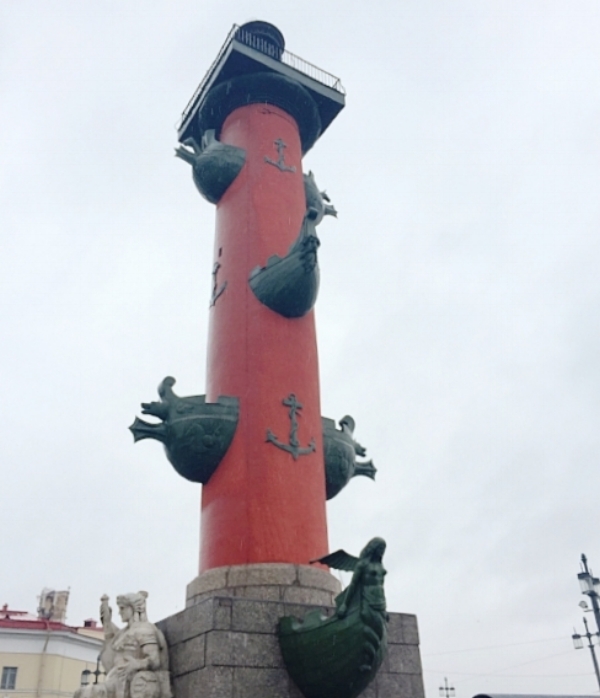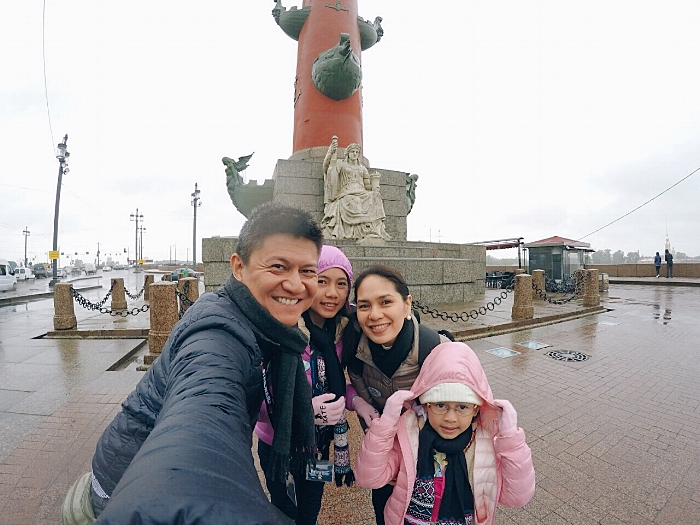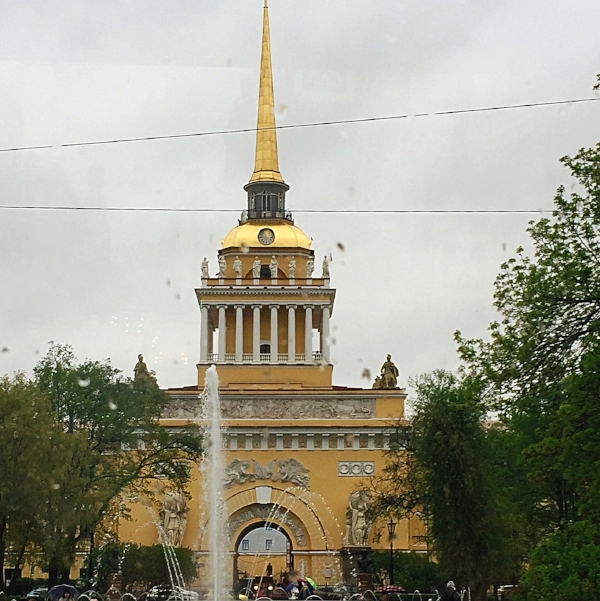Disney Cruise Baltic Sea: St. Petersburg
The Church of the Resurrection, also known as the "Savior on Spilled Blood," was built in memory of Alexander II who was assassinated in 1881. The church stands on the very ground where a bomb was thrown into Tsar's carriage by a young man who opposed his reforms.
Even as a child, I’ve always had a partiality to legends, mysteries, and the like. I don’t really know why I tend to gravitate to these stories, but I do. It’s primarily because of my taste for intrigue and paradoxes that I excitedly prepared for what awaited our family in St. Petersburg – I couldn’t wait to rekindle my love affair with the ill-fated Romanovs once again. Yes, I was one of those wishful romantics who wanted to believe that at least one of them survived -- and that one of them would’ve been Anastasia. It’s gone so far as a recent historical fictional/romance novel that immediately tickled by fancy entitled The Secret Wife by Gill Paul, needless to say, that I quickly devoured this book in no time.
Scanning through the different activities that the family could indulge in while in St. Petersburg, the tour that was most feasible to us was the basic tour. While the romantic and adventurous side in me wanted to venture and explore the entire city along with its museums and palaces, the packages on board only allowed us to select just one. I don’t think that I could’ve dragged my family to an entire day excursion to the city in the cold. Besides, the policies were strict when it came to the tourists in St. Petersburg, we couldn’t venture out on our own, we had to be accompanied by an accredited tour provider by Disney or have our own Russian Visa.
Chesmenskaya and Moreiskaya, the first two rostrum columns were built in the 1770s at Tsarskoe Selo in commemoration of the victories of the Russian Naval Fleet. From the very beginning, they served as beacons for the trading port. Inside these rostral columns are spiral staircases that lead up to the top where chalice-shaped lamps are set on tripods. These columns are gas beacons that have been lit for celebrations such as new year and other momentous events.
The Rostral Columns are classic examples of Greek Revival architecture.
During the reign of Tsar Peter the Great, he made reforms to reestablish Russia to a great nation and was the mastermind of St. Petersburg. The Tsar moved the country's capital from Moscow to St. Petersburg in 1712 making it Russia's cultural capital as well the nation's Imperial capital. While inside our bus, our tour guide explained that Tsar Peter the Great, a voracious traveler, erected the city to mimic other grand European capitals such as Paris. Designers and architects were requested to decorate the capital with colorful buildings to counteract the gloomy atmosphere that befalls Russia for most of the year.
Colorful buildings such as this one dot the city offering a rainbow of colors that delight the eyes.
Belosselsky Belozersky Palace is a Neo-Baroque palace at the intersection of the Fontanka River and Nevsky Prospekt. The palace once belonged to the Princes Beloselskiy, a family who claimed descent from Yuri Dolgorukiy, the founder of the city of Moscow.
Founded by Peter the Great in 1703, Peter and Paul Fortress is considered to be a unique fortification monument. Its architectural rendition is focused around the Cathedral of Saints Peter and Paul where most of the tombs of the Russian emperors can be found. Although it was named a fortress, its function was never actually so as it was mostly played host to a myriad of activities: a jailhouse as well as the burial ground for the Russian Imperial family, just to name a few.
It is in the Cathedral of Saints Peter and Paul where the remains of the last Tsar of Russia, Nicholas II along with other members of his family were laid to rest precisely 80 years after their execution by Bolshevik revolutionaries.
Church of the Savior on Spilled Blood
The Cathedral of the Savior on Spilled Blood draws people to its lavishly decorated five onion-domes covered in jeweler's enamel. It is decorated with Italian limestone and various semiprecious stones like Jasper, mountain crystal, and topaz just to name a few. It bears a similar façade to St Basil's Cathedral in Moscow, and most confuse the two landmarks for each other. The Church of the Savior on Spilled Blood took 24 years to construct and, after early Soviet vandalism, another 27 years to restore. The church's colorful exterior makes it stand out from St. Petersburg’s typical regulated architectural proportions and by the use of alternative color combinations.
The highlight of both the interior and exterior of the Cathedral are its mosaic collection based on the paintings of Russian artists such as Viktor Vasnetsov and Mikhail Vrubel. The cathedral boasts of one of the largest mosaic collections in Europe with a total area of 23130 square feet. There are are also twenty granite plates which tell the most important events of Alexander II's reign.
Saint Isaac's Cathedral or Isaakievskiy Sobor is known as the largest Orthodox church as well as the fourth largest cathedral in the world. It is dedicated to Saint Isaac of Dalmatia, a patron saint of Peter the Great, who had been born on the feast day of that saint. The neoclassical exterior shows the traditional Russian-Byzantine formula of a Greek-cross ground plan with a large central dome and four subsidiary domes.
St. Isaac's Cathedral was initially the city's main church and the largest cathedral in Russia. It was built between 1818 and 1858, by the French-born architect Auguste Montferrand to be one of the most impressive landmarks of the Russian Imperial capital.
The cathedral's facades are decorated with sculptures and whole massive pieces of granite columns while the interior is adorned with incredibly detailed mosaic icons, paintings, and columns made of malachite and lapis lazuli.
The church, designed to accommodate 14,000 standing worshipers, was closed in the early 1930s and was later reopened as a museum. Today, church services are held here only during significant ecclesiastical occasions.
The Hermitage Museum is a must-see for first-timers in St. Petersburg. Also dubbed as The Winter Palace, the Hermitage Museum is a fabulously large emerald, white, and gold building on the side of the Neva River that is the home to the most extensive collection of paintings in the world. The total number of pieces kept by the museum tallies to somewhere around 3 million. Created in 1764, the Hermitage was set as a private art collection of Empress Catherine the Great. She commanded Russian ambassadors around the world to purchase the best pieces of art they could find. Because of this, her collection grew and is currently one of the world's most important collections of art to date.
With such a large display of artwork, it is said that it would take eleven years for one to see each display for a minute. It would, therefore, be best for art aficionados to select specific tours that would interest them the most.
Palace Square was laid out in 1819-1829 by Carlo Rossi. He is known as neoclassicist architect of Italian descent who designed a quite a number of streets and squares around St. Petersburg. The emerald Baroque Winter Palace stands on the northern side of the square. While on the south side across the square lies a classical yellow and white General Staff Building also built by Rossi. This building encircles the southern side of the square, and through its central triumphal arch, one can reach the Nevsky Prospekt. On the eastern side, the structure of the former Royal Guards' General Staff enshrines the panorama of Palace Square, while on the west, the square borders with the Admiralty and the Alexander Garden.
Dvortsovaya ploshchad, otherwise known as the Palace Square in St. Petersburg, is one of the most beautiful and symmetrical architectural sites in the world. The Palace Square remains as the central public space of St. Petersburg throughout nearly three centuries.
This palace is known these days mostly for being the seat of the local Legislative Assembly. Nevertheless, it is an elegant palace situated just across the square from St Isaac's with a lot of history attached to it. In the beginning, the palace was built for the Grand Duchess Maria, daughter of Emperor Nicholas I during the years 1839 -1844. In 1884 the Mariinsky Palace was bought by the government and became the seat of the State Council, the State Chancellor's office and the Committee of Ministers, that later became known as the Council of Ministers. The palace has belonged to the city council and local administration since 1945.
The Mariinsky Palace is now considered an architectural landmark was designed by Andrei Stackenschneider.
The Monument to Nicholas I, located on St. Isaac's Square between the Mariinsky Palace and St. Isaac’s Cathedral was set in 1859 by a project of Auguste de Montferrand.
The pedestal of the monument holds an elliptical shape crafted from red Finnish granite, dark crimson porphyry, and white Italian marble. The base is made of gray granite of Serdobol. The pedestal of the monument is decorated with four allegorical female figures personifying: strength, wisdom, justice, and faith.
This is one of the most significant landmarks of St. Petersburg. It was originally constructed as a shipyard and is at present the Headquarters of the Russian Navy. Three central streets of St. Petersburg split off from the Admiralty Spire as three rays.: Nevsky Prospekt, Gorokhovaya Ulitsa (Pea Street), and Voznesensky Prospekt.
On the top of the 72.5-meter spire, one can see the symbol of St. Petersburg which is a gilded weather vane in the form of a ship. Legend has it that the silhouette of the weather vane mirrors that of the first ship which came into the port of St. Petersburg soon after the foundation of the city.
Kazan Cathedral is one of the biggest cathedrals in Saint Petersburg. It was built in the years 1801-1811 by the architect Andrey Voronikhin. He was instructed by Emperor Paul I to create a sanctuary to resemble that of St. Peter's Basilica in Vatican City. The building is a monument to the glory of the Russian arms where the famous Russian Field Marshal Mikhail Kutuzov, who won the most crucial campaign of 1812, was buried.
The Kazan Cathedral is dedicated to Our Lady of Kazan presumably the most venerated icon in Russia.
St. Petersburg, with the mere mention of the name, the place draws a variety of images from powerful Tsars, Fabergé eggs, vast collections of paintings and other artwork, lavish palaces and of course, a tumultuous past wrapped up in all its grandeur. Many people may have an alternative view of the former capital of Russia, but for me, it is a city that still imbibes an air of mystery and pizzaz ... and perhaps it will always remain that way. When we arrived at St. Petersburg, we were welcomed with gloomy skies and showers, but it still didn't take away the many facets that can be drawn from its colorful history and as well as its culture. My only wish was that I could spend more time and dug deeper into the city's Imperial yesteryear. Who knows, maybe after this visit, my family and I will have another go at it sometime in the future.

















